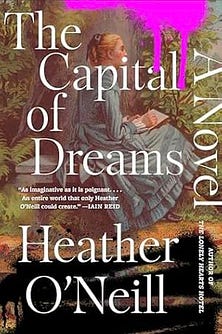The Capital of Dreams When the tiny country of Elysia is invaded by its neighboring country (known solely as the Enemy), the famous artist and writer Clara Bottom puts her fourteen-year-old daughter Sophia on a train heading out of the country, along with her last manuscript, which is hidden in a book of fairytales. When the train is intercepted by a force of the Enemy’s troops, Sophia escapes into the forest, only to discover that her mother’s manuscript has gone missing. Though she and her mother have had their differences, Sophia vows that she will do whatever it takes to find the manuscript and so she and a talking goose embark on a journey through the woods where creatures out of myth haunt the trees. But the monsters Sophia spies out of the corner of her eyes aren’t nearly as dangerous as the people she encounters. Though Heather O’Neill is a respected literary figure with books like The Lonely Hearts Hotel and Lullabies for Little Criminals, I hadn’t read any of her books before I picked up The Capital of Dreams so I didn’t know what to expect. Honestly, I’m still unsure of what to expect from O’Neill’s writing. Is The Capital of Dreams typical of her work, or is it an outlier? See, the story is written with fairytales in mind. Sophia grew up on fairy stories and is reluctant to let them go- understandable, as such tales provide plenty of consolation in hard times. What threw me off was O’Neill’s prose: though Sophia is fourteen and reaching toward adulthood, the book is written as though it is meant for a younger audience (for nine to twelve, perhaps) when it is definitely an adult story. It makes for a very disjointed reading experience when, on one page, Sophia is chatting away with the Goose about childish things, and then a few pages later, Sophia has a series of very frank thoughts about sex and sexuality. Still other times, Sophia comes face to face with death and descriptions of horrendous violence, but the prose sets all of this violence at a distance- until it doesn’t. There seems to be little rhyme or reason to it. And yet it all feels like O’Neill did it all on purpose. Sophia’s only defense mechanism to stay sane amidst the extreme violence she witnesses is to escape into a world of fairytales. With that in mind, it’s easy to understand why O’Neill’s prose is written the way that it is, with children’s stories in mind. For all that, I can’t say that I liked this book or found it compelling. Part of it had to do with the prose, which I quickly found irritating every time I picked it up again, and part of it had to do with the flashbacks. Nearly every other chapter flits away from Sophia’s journey through the forest and back in time to Sophia’s life with her mother before and during the war. Do those chapters help the reader understand Sophia’s choices by the end of the book? Yes. Did I find them completely aggravating? Also yes. I’m not a fan of flashbacks in general, though, so your mileage will vary based on whether or not you find them as annoying as I do. Overall, I can’t say The Capital of Dreams is a bad book. It’s not. O’Neill clearly knows what she is doing with her work, but it is not a book that I liked or enjoyed though I can understand why others would. Thank you to NetGalley and Harper Perennial for the free ebook in exchange for an honest review. Receipt of the ebook did not affect my opinions. Traveling in Books is free today. But if you enjoyed this post, you can tell Traveling in Books that their writing is valuable by pledging a future subscription. You won't be charged unless they enable payments. |
Ahad, 5 Januari 2025
Through the War-torn Woods
Langgan:
Catat Ulasan (Atom)
The architecture of respect.
Lasting influence is constructed brick-by-brick. ...

-
https://advanceinstitute.com.au/2024/04/24/sunnycare-aged-care-week-10/?page_id=...
-
barbaraturneywielandpoetess posted: " life on a rooftop can be short ; depends whether one looks down or up . ...

Tiada ulasan:
Catat Ulasan